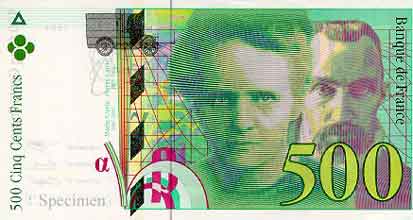Marie Curie (Maria Skłodowska-Curie, November 7, 1867 – July 4, 1934) was a Polish-born French chemist and pioneer in the early field of radiology and a two-time Nobel laureate. She founded the Curie Institutes in Paris and in Warsaw.
Biography
Born in Warsaw, Poland, her first years were sorrowful ones, marked by the death of her sister and, four years later, her mother. She was notable for her diligent work ethic, neglecting even food and sleep to study. After graduating from high school, she suffered a mental breakdown for a year. Due to her gender, she was not allowed admission into any Russian or Polish universities so she worked as a governess for several years. Eventually, with the monetary assistance of her elder sister, she moved to Paris and studied chemistry and physics at the Sorbonne, where she became the first woman to teach.

Portrait of Maria Skłodowska-Curie (circa 1898). Curie and her husband Pierre shared a Nobel Prize in Physics in 1903. Working together, she and her husband isolated Polonium. Pierre died in 1907, but Marie continued her work, namely with Radium, and received a Nobel Prize in Chemistry in 1911. Her death is mainly attributed to excess exposure to radiation. Until her granddaughter recently had them decontaminated her notes were radioactive.
At the Sorbonne she met and married another instructor, Pierre Curie. Together they studied radioactive materials, particularly the uranium ore pitchblende, which had the curious property of being more radioactive than the uranium extracted from it. By 1898 they deduced a logical explanation: that the pitchblende contained traces of some unknown radioactive component which was far more radioactive than uranium; thus on December 26th Marie Curie announced the existence of this new substance.
Over several years of unceasing labour they refined several tons of pitchblende, progressively concentrating the radioactive components, and eventually isolated initially the chloride salts (refining radium chloride on April 20, 1902) and then two new chemical elements. The first they named polonium after Marie's native country, and the other was named radium from its intense radioactivity.
Together with Pierre Curie and Henri Becquerel, she was awarded the Nobel Prize in Physics, 1903: "in recognition of the extraordinary services they have rendered by their joint researches on the radiation phenomena discovered by Professor Henri Becquerel". She was the first woman to be awarded a Nobel Prize.
Eight years later, she received the Nobel Prize in Chemistry, 1911 "in recognition of her services to the advancement of chemistry by the discovery of the elements radium and polonium, by the isolation of radium and the study of the nature and compounds of this remarkable element". In an unusual move, Curie intentionally did not patent the radium isolation process, instead leaving it open so the scientific community could research unhindered.
She was the first person to win or share two Nobel Prizes. She is one of only two people who has been awarded a Nobel Prize in two different fields, the other being Linus Pauling.
After her husband's death, she supposedly had an affair with physicist Paul Langevin, a married man who had left his wife, which resulted in a press scandal, invented by her academic opponents to smear her credibility. Despite her fame as an honored scientist working for France, the public's attitude to the scandal tended towards xenophobia—she was a foreigner, from an unknown land (Poland was still referred to as a geographical area, under the Russian Tsar), an area known to have a significant Jewish population (Marie was an atheist, raised a Catholic, but that didn't seem to matter). France at the time was still reeling from the effects of the Dreyfus affair, so the scandal's effect on the public was all the more acute. It is a strange coincidence that Paul Langevin's grandson Michel later married her granddaughter Hélène Langevin-Joliot.
During World War I, she pushed for the use of mobile radiography units for the treatment of wounded soldiers. These units were powered using tubes of radium emanation, a colorless, radioactive gas given off by radium, later to be identified as radon. Marie personally provided the tubes, milked from the radium she purified. Promptly after the war started, she cashed in her and her husband's gold Nobel Prize Medals for the war effort.
In 1921, she did a tour of the United States, where she was welcomed triumphantly, to raise funds for research on radium.
In her later years, she was disappointed by the myriad of physicians and makers of cosmetics who used radioactive material without precautions.
Her death near Sallanches, France in 1934 was from aplastic pernicious anemia, almost certainly due to her massive exposure to radiation in her work.
Her elder daughter, Irène Joliot-Curie, won a Nobel Prize for Chemistry in 1935, the year after Marie Curie's death. Her younger daughter, Eve Curie, wrote her biography Madame Curie after her death.
In 1995, Madame Curie was the first woman laid to rest under the famous dome of The Panthéon in Paris on her own merits. There is a 1943 U. S. Oscar-nominated film based on it. An extremely ahistorical Marie Curie appears as a character in the comedy Young Einstein by Yahoo Serious.
Element 96 Curium (Cm) was named in her and Pierre's honour.
Pierre and Marie Curie's daughter Irène Joliot-Curie and their son-in-law Frédéric Joliot-Curie were also physicists involved in the study of radioactivity (Nobel Prize for Chemistry in 1935).
Bibliography
- Madame Curie: A Biography, by Eve Curie, ISBN 0306810387
- Marie Curie: A Life, by Susan Quinn, ISBN 0201887940
- Obsessive Genius: The Inner World of Marie Curie, by Barbara Goldsmith, ISBN 0393051374
Links
Retrieved from "http://en.wikipedia.org/"
All text is available under the terms of the GNU Free Documentation License


 Disclaimer
Disclaimer  Privacy Policy
Privacy Policy